Introduction
Clustering is an essential tool for any writer looking to create compelling and cohesive pieces of writing. But what exactly is clustering? In its simplest form, clustering is the process of organizing information into related groups. It can help writers brainstorm ideas, develop topics, craft stories, and more. In this article, we’ll explore what clustering is and how it can be used to improve writing.
Exploring Clustering in Writing: What it is and How to Use it
Clustering is a powerful tool for writers, allowing them to brainstorm ideas, organize thoughts, and create cohesive pieces of writing. It can be used for many different types of writing, from essays to novels. Let’s take a closer look at clustering and how it works.
Overview of Clustering Techniques
Clustering involves grouping related ideas together and then connecting them to create a cohesive whole. The process can be broken down into two steps: brainstorming with clusters and creating clusters. Brainstorming with clusters involves generating ideas and grouping them into related categories. Creating clusters involves taking those ideas and organizing them into a structure that makes sense. Clusters can be organized by theme, chronology, characters, or any other method that works best for the writer.
Brainstorming with Clusters
When brainstorming with clusters, writers should begin by jotting down as many ideas as possible. These ideas can be related to a particular topic, character, or plot point. Once these ideas are written down, they can be grouped into related categories. For example, if a writer is creating a story about a family, they might group their ideas into categories such as “family dynamics,” “family secrets,” and “family relationships.” By grouping related ideas together, writers can easily see patterns and connections between ideas and begin to form a structure for their writing.

Clustering Techniques for Writers: An Introduction
Once writers have brainstormed ideas and grouped them into related categories, they can begin to create clusters. Clusters are simply groups of related ideas that are connected to each other. There are many different types of clusters, including linear clusters, radial clusters, and hierarchical clusters. Linear clusters involve connecting related ideas in a linear fashion, while radial clusters involve connecting related ideas around a central idea. Hierarchical clusters involve connecting related ideas in a hierarchical structure, with one idea at the top and others branching off from it.
Different Types of Clusters
Different types of clusters can be used for different types of writing. Linear clusters work well for outlining, listing facts, or writing a step-by-step guide. Radial clusters are useful for mapping out a story or exploring a theme. Hierarchical clusters are great for creating a narrative structure or exploring a character’s motivations.
Creating Clusters
Once writers have decided which type of cluster to use, they can begin to create their clusters. They should start by connecting related ideas, then adding details and examples to flesh out their clusters. Writers should also consider how their clusters will fit together to create a cohesive whole. For example, if a writer is writing a story, their clusters should connect in a way that builds a narrative arc.

Using Clustering to Create Cohesive Writing
Clustering can help writers create cohesive pieces of writing. By connecting related ideas, writers can create a unified structure for their writing that helps readers understand the main points. Let’s take a look at how clustering can be used to create cohesive writing.
Connecting Clusters
When using clustering to create cohesion, writers should start by connecting their clusters in a logical order. This will help ensure that the overall piece flows smoothly and that readers can follow the writer’s train of thought. Writers should also consider how their clusters can be used to emphasize certain themes or ideas. By connecting clusters in a way that reinforces key points, writers can create a more powerful piece of writing.
Building a Narrative
Clusters can also be used to build a narrative. Writers can use clusters to map out the plot of their story, explore characters’ motivations, or add tension and suspense. By connecting clusters in a way that builds a narrative arc, writers can create an engaging and captivating story.
Writing with Clusters: A Step-by-Step Guide
Now that you know what clustering is and how it can be used to create cohesive writing, let’s look at a step-by-step guide for writing with clusters. Here’s how to get started:
Brainstorming Ideas
The first step in writing with clusters is to brainstorm ideas. Start by jotting down as many ideas as possible, without worrying about whether they’re good or bad. Once you have a list of ideas, start grouping them into related categories.
Grouping and Organizing Ideas
Once you’ve grouped your ideas into related categories, it’s time to start organizing them into clusters. Choose the type of cluster you want to use and start connecting related ideas. As you create your clusters, consider how they will fit together to create a cohesive whole.
Crafting Sentences and Paragraphs
Once your clusters are in place, you can start crafting sentences and paragraphs. Begin by writing down the main points of each cluster and then expand on them with details and examples. Keep in mind how your clusters will fit together to create a unified structure for your writing.

Harnessing the Power of Clustering for Writing Success
Clustering is a powerful tool for writers, allowing them to brainstorm ideas, organize their thoughts, and create cohesive pieces of writing. To make the most of clustering, writers should strive to understand how it works and practice using it. They should also consider how clustering can be applied to different genres, such as fiction, nonfiction, and poetry.
Conclusion
Clustering is a powerful tool for writers, allowing them to brainstorm ideas, organize their thoughts, and create cohesive pieces of writing. By understanding how clustering works and practicing using it, writers can harness its power to create compelling and engaging pieces of writing.
(Note: Is this article not meeting your expectations? Do you have knowledge or insights to share? Unlock new opportunities and expand your reach by joining our authors team. Click Registration to join us and share your expertise with our readers.)
